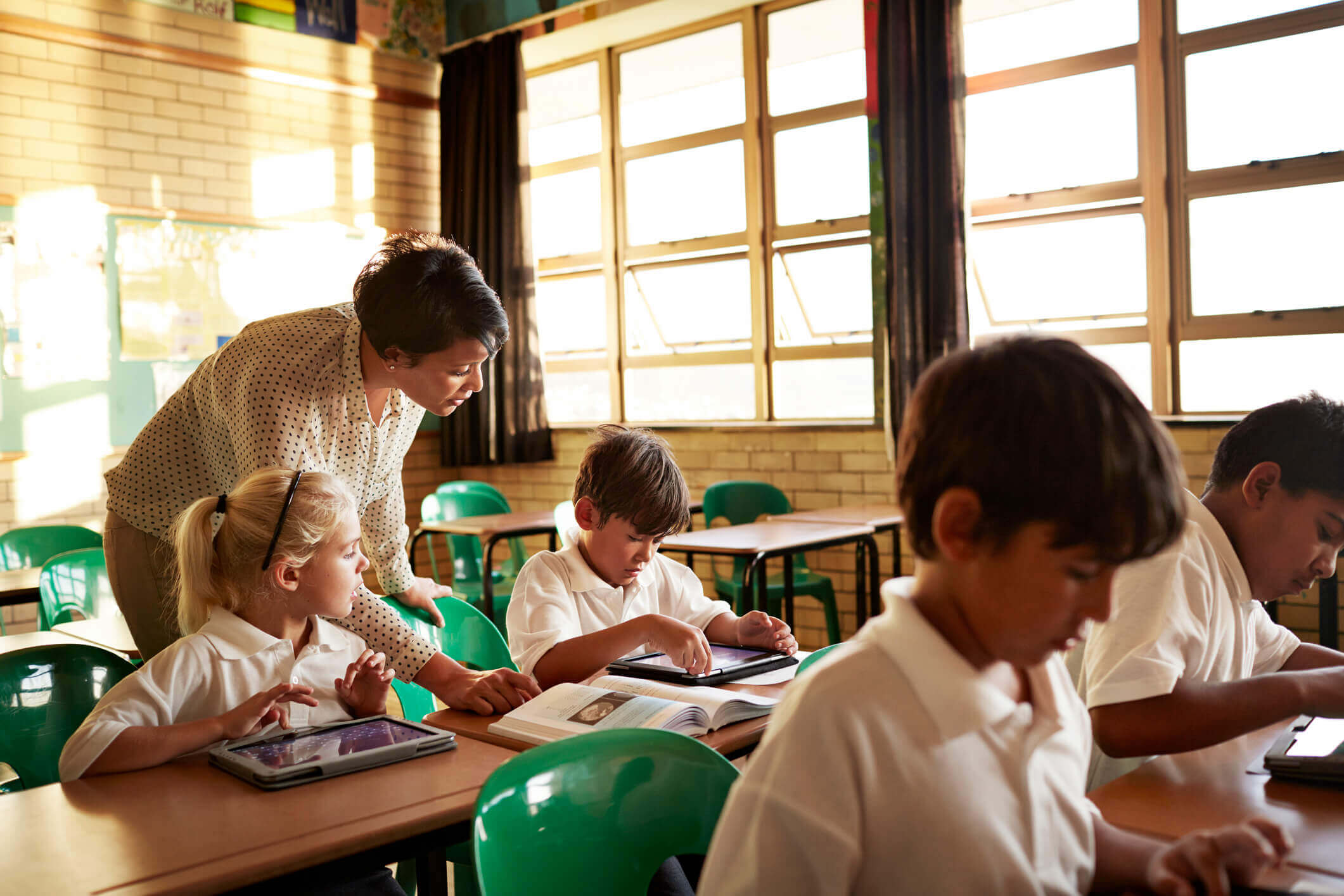Published on July 5th, 2023
How to Teach Children with a Visual Learning Style
16 minute read

Learning styles are based on the theory that everyone learns in different ways. Some people learn better when they can see the information in front of them, whereas others learn better when they can hear the information being presented to them.
Visual learners are the most common type of learners, making up 65% of the global population. They learn best when using pictures, diagrams, graphs, and charts.
This article will explore the visual style of learning and provide you with effective, easy-to-action tips on how you can engage with visual learners in your classroom.
A quick recap on learning styles
The VARK learning styles model theorises that everyone has a preference when it comes to how they learn and process information. The four learning styles, visual (V), auditory (A), read/write (R), and kinesthetic (K), were first presented in the 1960s.
For all the information you could need, take a look at our ultimate guide to learning styles in the classroom.
So, what is visual learning and how does it differ from other learning styles? Visual learners prefer to use images to understand information. Auditory learners prefer to listen and speak to understand information, such as in verbal lectures.
Some students prefer to read and write when it comes to understanding information, and so are said to have a reading and writing learning style. Finally, kinaesthetic learners understand information through hands-on activities.
Knowing what style of learning your students prefer can help you understand their strengths and weaknesses. This can then help you to help them succeed in their studies.
What is a visual learning style?
A visual learner is someone who needs to see information in order to process, memorise and understand it. Also known as spatial learning, it is how most people prefer to learn information.
Visual learners are more likely to absorb information if it’s presented in images instead of relayed out loud or written down for them to read. By translating complex ideas and concepts into visual content, it can be simplified and more easily understood.
Some examples of the aids used in visual learning include charts, graphs, diagrams, and mind maps.
How do I know if I have a visual learning style?
Most people know what style of learning they have but there are some steps you can take to find out for certain.
For example, think back to a time when you had to study for a test or learn something new. How did you ensure you processed the information in front of you? If it was through images, graphs, or mental imagery, you’re probably a visual learner. If it was through listening to lectures, podcasts, or voice recordings, you’re probably an auditory learner.
There are also various tests online where you can answer a few questions to find out what style of learning you prefer. Some people learn best with a mix of different learning styles. However, in most cases, one works better than the other.
Traits of a visual learner
Students with visual learning styles are concerned with the information around them. They are more likely to look around and fully examine a situation instead of asking questions to get a better idea of what they are dealing with.
Most visual learners also have vivid imaginations and are good storytellers. Another common trait among visual learners is being good at remembering faces but easily forgetting names.
How to teach children with a visual learning style
Most classrooms are comprised of a wide range of learning styles. This can make it difficult to cater your teaching strategies to each individual child. However, there are some visual learning strategies you can employ to ensure each child is supported.
For example, as well as giving verbal directions, ensure new concepts and instructions are also written down. Something as simple as a quick description, bullet point list or diagram on the board can make a huge difference to a visual learner.
Similarly, using an interactive whiteboard can help visual learners make sense of the information being taught. Using different coloured pens to organise information, add labels and highlight key concepts can also help visual learners to understand more complex subjects.
Playing games with visual aids, such as flashcards or mini whiteboards, is another great way to get students interacting visually with the information they are being taught. Interacting with visual tools in smaller groups can lead to better student engagement.
How not to teach children with a visual learning style
So, we know the teaching methods that are most effective when used with visual learners, but what about those that aren’t quite so helpful?
Of course, teaching in a way that suits every different type of learner in your classroom is exceedingly difficult, but there are certain things you should avoid when trying to create lesson plans that are focused on supporting the visual learners in the room.
Firstly, when explaining complex ideas, you should never rely on your voice alone. Whilst this might be more than enough for auditory learners, visual learners are unlikely to properly process the information or even keep up as you move from one concept to the next. Drawing simple doodles on the board whilst you’re talking can help form an idea in a visual learner’s mind.
Giving students written study material for an upcoming test or exam can also pose problems for visual learners. Some subjects might include more images and diagrams than others but explaining things using visual aids can help to keep them engaged and improve their ability to retain information.
How to engage visual learners of all ages
Knowing how to engage visual learners of all ages is a valuable skill to have. Regardless of your students’ ages, incorporating visual cues into your lessons can help you cater to each learner.
From spelling to algebra, almost every lesson can include visual examples.
How to engage visual learners in primary school
The first few years of a child’s life are crucial for their learning and development. For children that are visual learners, the way information is presented to them at primary school can have a lasting effect.
For spelling, write out the word multiple times. Use colour to emphasise certain patterns or sounds. Displaying words around the classroom can also help the information stick, as well as creating captivating displays on the interactive whiteboard.
Visual learners can get to grips with basic mathematics much quicker when they can represent numbers with other visual aids. For example, using dice, coloured blocks, and counters can help students to see the maths problems they are solving in physical terms.
How to engage visual learners in secondary school
Secondary school curriculums tend to include less visual information and more complex letters, numbers, and symbols. This can make school difficult for visual learners, but there are things you can do to ensure they are fully engaged.
Presentations, textbook diagrams, and documentaries can help a visual learner process difficult or complex information.
Encouraging students to take notes in whatever way they wish can also help visual learners. Information you would usually present in a series of sentences can be translated into a table or even colour-coded paragraphs.
When studying for tests, encourage visual learners to highlight their notes and use mindmaps to emphasise the most important elements or ideas, exploring what works best for them. This will help them to retain the information more readily and reproduce it when it’s time for the exam.
How to engage visual learners in higher education
Students in higher education are usually given more freedom to choose how they wish to learn and study. Most classes are taught through spoken lectures and seminars but note-taking is up to the individual student.
Using presentations with graphs, diagrams, and charts can help students understand information quicker. This can also help break up wordy text and give students an opportunity to process the information they’ve just learned. This is where effectively and innovatively using interactive whiteboards in higher education can prove really beneficial, by breaking away from the stereotype of boring, unengaging lectures.
Since university or college students do exercise a far greater degree of autonomy when it comes to deciding how they want to learn, consider signposting them towards resources about learning styles that they can pick up in their own time. Helping them to understand the theory behind how they learn could push them to tweak their revision strategies or note-taking methods going forwards.
The benefits of having a visual learning style
Having a visual style of learning usually means you have a strong visual recall of words. This is why many visual learners are also good at spelling, as they can visualise the word in their mind, one letter at a time.
People with a visual style of learning also tend to have a better photographic memory and are good at remembering places and faces. This can be useful when studying and travelling.
Communicating with other visual learners also comes naturally to people with a visual style of learning. As most visual learners process information the same way, collaborating on projects or studying together is common.
How to plan lessons that accommodate visual learners
Planning lessons to accommodate a small portion of your class might sound time-consuming. But it only requires a few changes to your usual teaching technique. From incorporating visual cues to watching an instructional video, there are various things you can do to help students feel supported.
Classroom activities for visual learners
Visual learning strategies can help students have fun and feel accommodated in the classroom. Some examples include mind maps, photo essays, flowcharts, diagrams, and picture books.
Using mini whiteboards for tests or for checking students’ understanding of a topic is also useful. Students get the opportunity to be creative and you can make sure they understand what you’re teaching them.
Additionally, using an interactive display, like the ActivPanel, can benefit visual learners too. The ActivPanel features a screenshare functionality that lets you share work from the interactive whiteboard to an iPad, so you can give visual learners a closer look at material that has been presented to the whole class.
Playing visual games, such as Pictionary and Dobble, can also help students explain their thoughts through imagery – either using paper and pen or your interactive whiteboard. Plus, this can help non-visual learners understand what it’s like to learn visually.
Using technology to appeal to visual learners
Over the years, technology has played an increasingly large role in the classroom. But as well as increased engagement and collaboration, it has also helped students with visual styles of learning gain a better understanding of complex ideas.
For example interactive displays, such as our ActivPanel display, have allowed teachers to visually explain topics as they’re discussing them. This can help students learn information in a way that works for them.
Online videos can also help students that are easily distracted in lectures. By giving them something to watch and focus on, they are more likely to retain the information they are presented with.
Finally, visual learning software can revolutionise the learning process for students with a visual style of learning. There are various platforms, websites, and apps designed to make classes interactive and informative for students that have to see information to absorb it.
Frequently asked questions about visual learners
Can you have multiple learning styles at once?
Yes, it is possible to have multiple learning styles at once. Some students enjoy a combination of visual and auditory learning. Others prefer a mix of verbal and kinesthetic. Ensuring your teaching style incorporates each learning style can help students feel supported.
Is it good to be a visual learner?
Being a visual learner often means you have a better memory and can store information for longer. However, there is no way of learning that is better than another.




